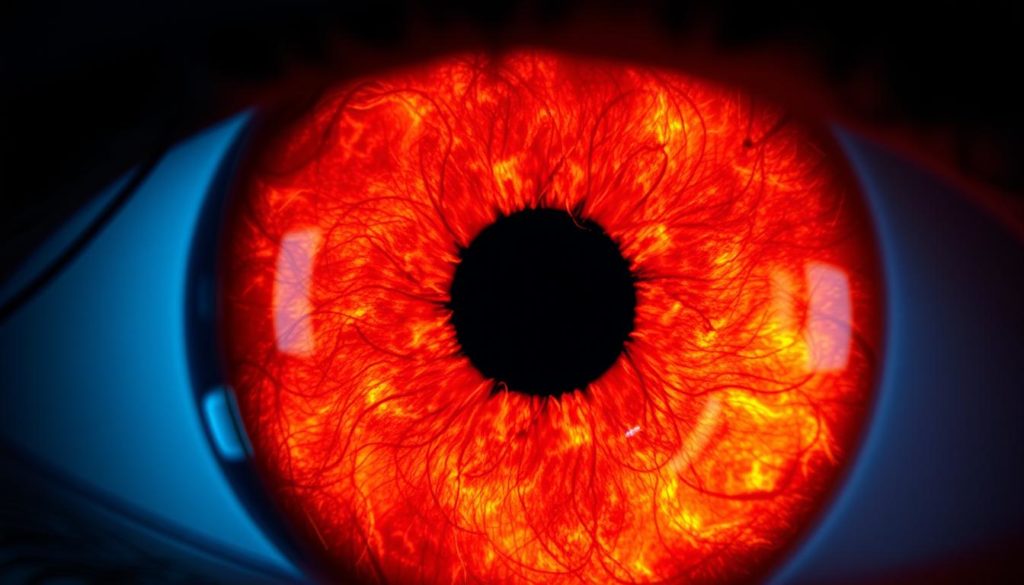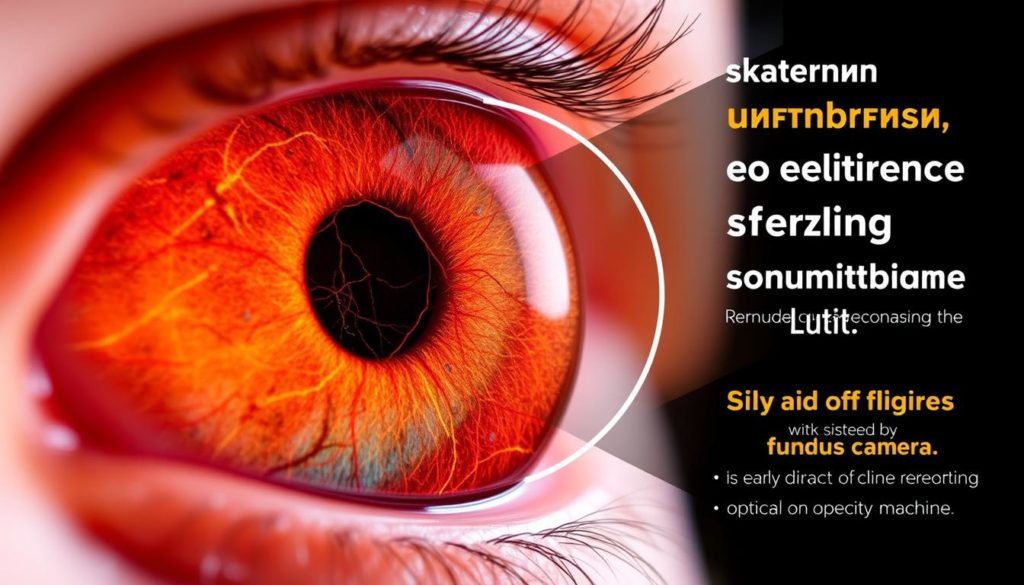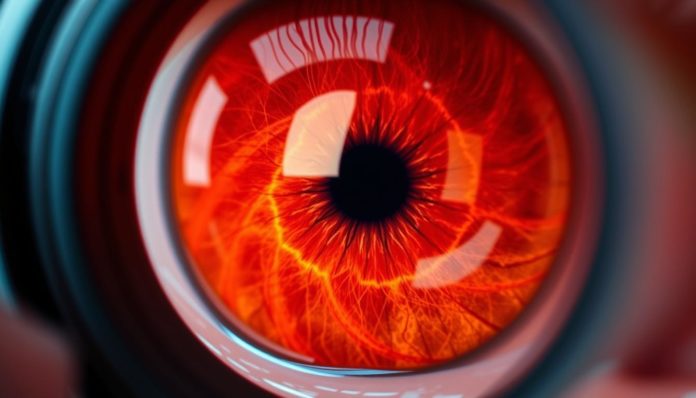Did you know that over 93 million people worldwide live with diabetic retinopathy? This condition can be monitored with advanced retinal imaging. This technology is key to keeping eyes healthy. It takes detailed pictures of the retina, optic disc, and blood vessels without causing pain.
Retinal imaging is more than just a tool for eye exams. It helps detect and diagnose eye diseases, especially those linked to diabetes. The results are ready right away, leading to quick consultations and early treatments that can change lives.
What is Retinal Imaging?
Retinal imaging uses advanced technology to take a detailed digital picture of the back of the eye. This gives a clearer view than old ophthalmoscopes, helping doctors check eye health. It helps spot diseases like diabetic retinopathy, macular degeneration, and glaucoma early on.

Definition and Overview
Retinal imaging is a way to take pictures of the retina using digital technology. It’s easy and doesn’t hurt, making it key in eye care today. This tech spots changes in the retina that could mean health problems, giving doctors important clues about your health.
With top-notch medical imaging tools, doctors can make accurate diagnoses and plan treatments.
History of Retinal Imaging
The history of retinal imaging has seen big changes. Early methods were basic and didn’t show much. But, big steps in medical imaging have brought us advanced tools like OCT and digital fundus photography.
These tools have made retinal imaging a key part of eye care. They help catch and treat eye problems early.
How Retinal Imaging Works
Retinal imaging is key in modern eye care. It uses different methods to take detailed pictures of the retina. Each method has its own way of working, helping in complete retina checks and better medical images.
Fundus Photography
Fundus photography takes pictures of the retina with bright flashes. These flashes show signs of retinopathy and age-related macular degeneration. Sometimes, the eyes need to be dilated for clear photos.
Optical Coherence Tomography (OCT)
Optical Coherence Tomography (OCT) shows detailed cross-sections of the retina. Doctors use it to spot conditions like macular edema and macular degeneration. It uses light waves for images, so no dye or contrast is needed.

Fluorescein Angiography
Fluorescein Angiography injects a dye into the bloodstream. This dye lights up the retina’s blood vessels. It helps find problems and check for diabetic retinopathy. But, you might feel sensitive to light after the test.
Benefits of Retinal Imaging
Retinal imaging gives a deep look into eye health, offering many benefits. It improves the quality of eye care services.
Early Detection
Retinal imaging is key for catching eye problems early. It spots issues like diabetic retinopathy, glaucoma, and macular degeneration before they show up. This means treatment can start early, helping to prevent serious vision loss.
Non-invasive and Painless Procedure
The retinal scan is easy and doesn’t hurt. It uses technology to take detailed images without touching the eye. This makes patients more likely to get regular check-ups, helping with early detection.
Creates a Record of Ocular Health
Retinal imaging also keeps a detailed eye health record. The images from scans can be stored and looked at later. This helps doctors track changes, understand condition progress, and plan treatments better.
| Benefits | Description |
|---|---|
| Early Detection | Identifies eye conditions before noticeable symptoms, enabling timely treatment. |
| Non-invasive and Painless | Uses advanced technology to capture images without discomfort. |
| Ocular Health Record | Stores detailed images to monitor and manage eye health over time. |
Conditions Detectable Through Retinal Imaging
Retinal imaging is key to eye health, offering a detailed way to spot various eye problems. It uses advanced techniques to show potential issues. This helps in early detection and better patient care.
Diabetic Retinopathy
Diabetic retinopathy is a common eye issue in diabetes. It happens when blood vessels in the retina get damaged. If not treated, it can cause vision loss. Regular retinal imaging checks the condition’s progress and helps in early action.
Macular Degeneration
Macular degeneration, in both wet and dry forms, can be seen with retinal imaging. It’s an age-related condition that harms the retina’s central part, leading to vision loss. Doctors use retinal imaging to monitor changes and plan treatments.
Glaucoma
Retinal imaging greatly helps in detecting glaucoma. This condition raises the pressure inside the eye, which can harm the optic nerve and lead to blindness. Catching it early with imaging is key to managing glaucoma and saving vision.
Hypertension-Related Issues
Retinal imaging is also crucial for spotting eye problems linked to high blood pressure. High pressure can change the retinal blood vessels, causing serious issues. Imaging shows these changes, helping in full health checks.
| Condition | Description | Detection Method |
|---|---|---|
| Diabetic Retinopathy | Damage to retinal blood vessels due to diabetes | Retinal Imaging |
| Macular Degeneration | Deterioration of the retina’s central portion | Retinal Imaging |
| Glaucoma | Increased intraocular pressure damaging the optic nerve | Retinal Imaging |
| Hypertension-Related Issues | Changes in retinal blood vessels due to high blood pressure | Retinal Imaging |
Diabetic Retinopathy and Retinal Imaging
Diabetic retinopathy is a serious eye condition that can lead to blindness. It’s vital to watch for it closely. Using advanced imaging helps spot and manage this disease early. Catching it early can save your sight.
Importance of Regular Screening
Checking your eyes often is key in fighting diabetic retinopathy. This helps spot early signs before they become worse. By using retinal imaging, doctors can quickly find any problems in people with diabetes.
Detection and Management
Tools like fundus photography and OCT show tiny changes in the retina. This helps doctors make the right treatment plans. Regular eye checks and these imaging tools are crucial in managing diabetic retinopathy well.
A study on retinal imaging shows how early detection and regular checks help manage the disease. It highlights how imaging helps improve vision in diabetic patients.
| Retinal Imaging Techniques | Benefits |
|---|---|
| Fundus Photography | Non-invasive, captures detailed retinal images |
| Optical Coherence Tomography (OCT) | Provides cross-sectional views of the retina |
| Widefield Imaging | Offers expansive views of the retina |
| Ultra-widefield Angiography | Visualizes blood flow in retinal vessels |
The Role of Retinal Imaging in Routine Eye Exams
Retinal imaging is a big step forward in eye care. It works well with traditional methods, making eye exams more precise and reliable.
Complementary to Traditional Eye Exams
Traditional eye exams are good, but they can’t see the eye’s deeper layers. Retinal imaging fills this gap. It gives a detailed look at the retina, helping to spot and diagnose eye problems. This makes eye exams more thorough.
Integration into Yearly Check-ups
Adding retinal imaging to yearly eye check-ups helps keep track of eye health. It lets doctors catch problems early and treat them quickly. This way, patients and doctors can keep an eye on changes and take action fast.
How to Prepare for a Retinal Imaging Test
Getting ready for a retinal imaging test is easy with a few steps. Knowing what to do before and after can make you feel more at ease.
Pre-test Instructions
Before your test, you might need to dilate your pupils. This lets doctors see your retina clearly. Wear sunglasses after the test because your eyes will be sensitive to light. Also, have someone drive you home.
During the Test
You’ll rest your head on a support during the test. Look straight ahead without blinking for a few seconds. The whole process is quick and won’t hurt.
Post-test Care
After the test, take care of your eyes. Don’t look at bright lights right away. Wear sunglasses to ease the discomfort from dilation. If you wear contact lenses, skip them for the day. These steps help your eyes recover fast and comfortably.
| Preparation Step | Instructions |
|---|---|
| Before the Test | Ensure you have a driver; prepare for dilation. |
| During the Test | Stay still and look straight ahead. |
| After the Test | Wear sunglasses, avoid contact lenses. |
The Technology Behind Retinal Imaging
Retinal imaging technology has changed how eye care professionals diagnose and treat eye problems. At the heart of these changes are advanced camera systems and top-notch image enhancement tech. These tools are key for getting clear and precise images of the retina.
Advanced Camera Systems
Today’s retinal imaging uses cameras that take high-resolution, wide views of the retina. These cameras use tech like color fundus photography and optical coherence tomography (OCT). This tech not only gives clear images but also helps doctors spot and track eye diseases.
Learn more about retinal imaging to see how these cameras help catch diseases early and manage them.
Image Enhancement Technology
Image enhancement tech is also vital in retinal imaging. It uses various methods to make retinal images clearer and more detailed. This tech helps doctors make more accurate diagnoses and track how diseases change over time. It’s really useful in teleretinal imaging, where doctors need clear images for remote checks.
Key benefits of image enhancement tech include:
- Improved clarity of retinal images
- Better contrast to spot problems
- Enhanced tracking of disease changes
By using advanced cameras and image enhancement tech, eye care pros can offer more thorough care. This leads to better results for patients.
Improving Accessibility with Teleretinal Imaging
Teleretinal imaging has changed eye care for the better. It makes getting eye exams easier for people in remote places. This technology lets patients skip the long trips to big cities for eye tests.
Expanding Access to Underserved Areas
In rural areas, getting to eye specialists is hard. Teleretinal imaging helps by sending eye pictures to doctors far away. This way, people in remote places can get the eye care they need without leaving home.
It also means faster diagnosis and treatment. This is good for eye health in these areas.
Reducing Costs for Patients and Providers
Teleretinal imaging also lowers healthcare costs. Patients save on travel and work time. Providers save on the cost of exams and keep patient records up to date easily.
This leads to lower costs and better health outcomes for everyone.
FAQ
What is Retinal Imaging?
Retinal imaging uses advanced tech to take pictures of the retina and blood vessels at the back of the eye. It’s a non-invasive way to spot eye diseases early. It also helps with regular eye exams.
How does Fundus Photography work?
Fundus photography takes detailed images of the back of the eye with a special camera and bright flash. It shows conditions like retinopathy by giving a clear view of the retina and blood vessels.
What is Optical Coherence Tomography (OCT)?
Optical Coherence Tomography (OCT) gives detailed views of the retina layers. It’s key for spotting conditions like macular edema and degeneration.
Why is retinal imaging important for diabetic retinopathy detection?
Retinal imaging is key for catching diabetic retinopathy early. This disease can cause blindness if not caught. Regular scans help spot signs early, improving treatment outcomes.
What are the benefits of retinal imaging?
Retinal imaging finds eye diseases early, is non-invasive, and creates detailed health records. These records track changes over time.
What conditions can be detected through retinal imaging?
It can spot diabetic retinopathy, macular degeneration, glaucoma, and eye issues from high blood pressure. Early detection is key for better treatment.
How should I prepare for a retinal imaging test?
You might need your pupils dilated, so plan for temporary vision changes. Don’t wear contact lenses during the test.
What should I expect during a retinal imaging test?
You’ll keep your head and eyes still while pictures are taken. The test is quick and doesn’t hurt, but you might feel sensitive to light later.
How do advanced camera systems enhance retinal imaging?
New camera systems give sharp, wide views of the retina. These tech upgrades lead to clearer images and more precise diagnoses.
What is teleretinal imaging?
Teleretinal imaging uses digital tech to send retinal images to doctors far away for review. It makes eye care easier to get in remote areas and cuts costs.


